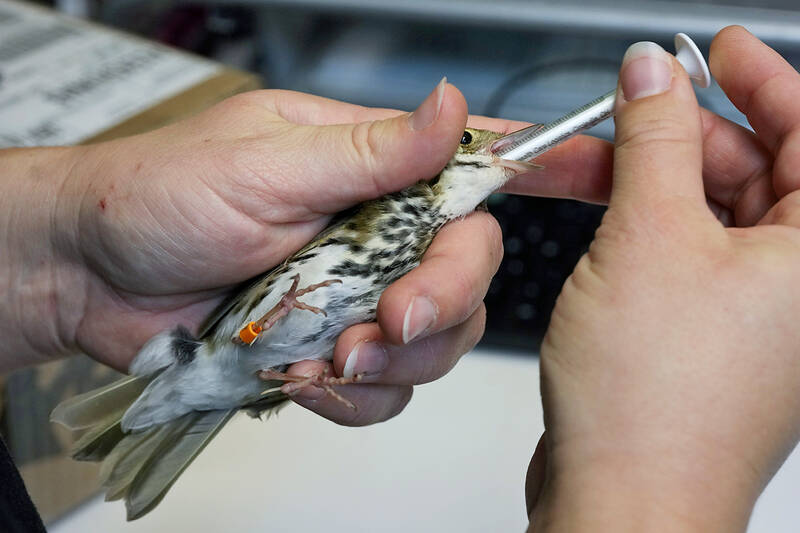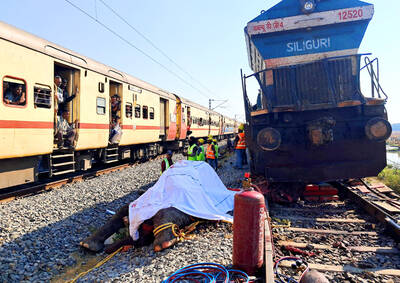With a neon-green net in hand, Annette Prince briskly walks a downtown Chicago plaza at dawn, looking left and right as she goes.
It is not long before she spots a tiny yellow bird sitting on the concrete. It does not fly away and she quickly nets the bird, gently places it inside a paper bag and labels the bag with the date, time and place.
“This is a Nashville warbler,” said Prince, director of the Chicago Bird Collision Monitors, adding that the bird must have flown into a glass window pane of an adjacent building. “He must only weigh about two pennies. He’s squinting his eyes because his head hurts.”

Photo: AP
For rescue groups like the Chicago Bird Collision Monitors, this scene plays out hundreds of times each spring and fall after migrating birds fly into homes, small buildings and sometimes Chicago’s skyscrapers and other hulking buildings.
A stark sign of the risks came last fall, when 1,000 migrating birds died on a single night after flying into the glass exterior of the city’s lakefront convention center, McCormick Place.
This fall, the facility unveiled new bird-safe window film on one of its glass buildings along the Lake Michigan shore.
The US$1.2 million project installed tiny dots on the exterior of the Lakeside Center building, adorning enough glass to cover two football fields.
Doug Stotz, senior conservation ecologist at the nearby Field Museum, hopes the project will be a success. He estimated that just 20 birds have died after flying into the convention’s center’s glass exterior so far this fall, a hopeful sign.
“We don’t have a lot of data since this just started this fall, but at this point, it looks like it’s made a huge difference,” Stotz said.
However, for the birds that collide with Chicago buildings, there is a network of people waiting to help. They also are aiming to educate officials and find solutions to improve building design, lighting and other factors in the massive number of bird collision deaths in Chicago and worldwide.
Prince said she and other volunteers walk the streets downtown to document what they can of the birds that are killed and injured.
“We have the combination of the millions of birds that pass through this area because it’s a major migratory path through the United States, on top of the amount of artificial lighting that we put out at night, which is when these birds are traveling and getting confused and attracted to the amount of glass,” Prince said.
Dead birds are often saved for scientific use, including by Chicago’s Field Museum of Natural History. Rescued birds are taken to local wildlife rehabilitation centers to recover, such as the DuPage Wildlife Conservation Center in suburban Illinois.
On a recent morning, veterinarian Darcy Stephenson at DuPage gave a yellow-bellied sapsucker anesthetic gas before taping its wings open for an X-ray.
The bird arrived with a note from a rescue group: “Window collision.”
Examining the results, she found the bird had a broken ulna — a bone in the wing.
The center takes in about 10,000 species of animals annually and 65 percent of them are avian. Many are victims of window collisions and during peak migration in the fall, several hundred birds can show up in one day.
“The large chunk of these birds do actually survive and make it back into the wild once we’re able to treat them,” said Sarah Reich, head veterinarian at DuPage. “Fractures heal very, very quickly in these guys for shoulder fractures. Soft tissue trauma generally heals pretty well. The challenging cases are going to be the ones where the trauma isn’t as apparent.”

REVENGE: Trump said he had the support of the Syrian government for the strikes, which took place in response to an Islamic State attack on US soldiers last week The US launched large-scale airstrikes on more than 70 targets across Syria, the Pentagon said on Friday, fulfilling US President Donald Trump’s vow to strike back after the killing of two US soldiers. “This is not the beginning of a war — it is a declaration of vengeance,” US Secretary of Defense Pete Hegseth wrote on social media. “Today, we hunted and we killed our enemies. Lots of them. And we will continue.” The US Central Command said that fighter jets, attack helicopters and artillery targeted ISIS infrastructure and weapon sites. “All terrorists who are evil enough to attack Americans are hereby warned

‘POLITICAL LOYALTY’: The move breaks with decades of precedent among US administrations, which have tended to leave career ambassadors in their posts US President Donald Trump’s administration has ordered dozens of US ambassadors to step down, people familiar with the matter said, a precedent-breaking recall that would leave embassies abroad without US Senate-confirmed leadership. The envoys, career diplomats who were almost all named to their jobs under former US president Joe Biden, were told over the phone in the past few days they needed to depart in the next few weeks, the people said. They would not be fired, but finding new roles would be a challenge given that many are far along in their careers and opportunities for senior diplomats can

Seven wild Asiatic elephants were killed and a calf was injured when a high-speed passenger train collided with a herd crossing the tracks in India’s northeastern state of Assam early yesterday, local authorities said. The train driver spotted the herd of about 100 elephants and used the emergency brakes, but the train still hit some of the animals, Indian Railways spokesman Kapinjal Kishore Sharma told reporters. Five train coaches and the engine derailed following the impact, but there were no human casualties, Sharma said. Veterinarians carried out autopsies on the dead elephants, which were to be buried later in the day. The accident site

RUSHED: The US pushed for the October deal to be ready for a ceremony with Trump, but sometimes it takes time to create an agreement that can hold, a Thai official said Defense officials from Thailand and Cambodia are to meet tomorrow to discuss the possibility of resuming a ceasefire between the two countries, Thailand’s top diplomat said yesterday, as border fighting entered a third week. A ceasefire agreement in October was rushed to ensure it could be witnessed by US President Donald Trump and lacked sufficient details to ensure the deal to end the armed conflict would hold, Thai Minister of Foreign Affairs Sihasak Phuangketkeow said after an ASEAN foreign ministers’ meeting in Kuala Lumpur. The two countries agreed to hold talks using their General Border Committee, an established bilateral mechanism, with Thailand